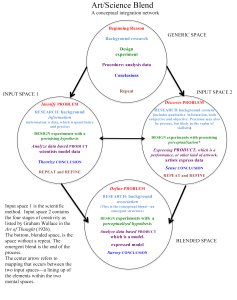Art-Science Is a Conceptual Blend
Editorial by Jack Ox
The art world is, as always, engaged in the boomlets of the moment; right now, that includes art-science. This is a good reason to establish a procedure for determining what art-science is. For instance, is it art-science if a painter makes a painting of a Petri dish?
How about a painter creating a rendition of images taken from a high-powered molecular microscope? Is that art-science, or is it closer to a still life or landscape painting? How do we classify something as art-science? We need first to define what art-science means and then to determine a way to measure the properties of the different elements that constitute a work. There must be different properties that exist in different works; art-science is a hybrid form that in the end creates an emergent form somewhere between art and science. I propose that the Leonardo community of experts should develop a way to analyze works and place them on the continuum that runs between the two source domains. I have found in my research that the two domains form an emergent structure through a process of conceptual blending; this is in opposition to a mapping process where one domain supplies the structure for another. John Seely Brown described this process as it happened during Xerox PARC’s artist-in-residence program:
The output of these pairings is both interesting art and new scientific innovations. The artists revitalize the atmosphere by bringing in new ideas, new ways of thinking, new modes of seeing and new contexts for doing [1].
Gilles Fauconnier developed the double-scope integration network in order to chart out the different elements of a conceptual blend. It usually includes four spaces: the top container contains the generic elements of the blend; below that, on the left and right sides of the page, are two input spaces; the bottom space contains the blend of the two input spaces. The input spaces contain specific names for agents and entities that appear in each domain. Each space has information from only one source, and there must be structural consistency between the input spaces. I have diagrammed a blend between art and science here (Fig. 1).
 Fig. 1. The diagram shown here charts the different elements of a conceptual blend between art and science. Diagram by Jack Ox.
Fig. 1. The diagram shown here charts the different elements of a conceptual blend between art and science. Diagram by Jack Ox.
The generic space contains: (1) The reason for the work; (2) Background research; (3) Experiment design; (4) The procedure for analyzing data; (5) Conclusions; (6) Repeat.
In the first input space, as an example, I entered the scientific method: (1) Identify the problem; (2) Research: background information (information is data, which is quantitative and precise); (3) Design an experiment with a promising hypothesis; (4) Analyze the data-based product and create a model from the data; (5) Theorize a conclusion; (6) Repeat and refine. For the second input-space I used the four stages of creativity as listed by Graham Wallace in The Art of Thought (1926): (1) Discover the problem; (2) Research background content (including qualitative information, both subjective and objective); (3) Design experiments with promising perceptualization; (4) Product expression: a performance or other kind of artwork, such as an image or a sound creation––-an artists’ expression of data; (5) Sense conclusion; (6) Refine.
The blended space is the container on the bottom of the page, vertically aligned with the generic space at the top. It is a conceptual blend of the two input spaces: (1) Define problem; (2) Research––-background association (this is the conceptual blend––-an emergent structure); (3) Design experiments with perceptualized hypotheses; (4) Analyze the data-based product, which is a model; (5) Model expression; (6) Conclusion survey (quality analysis).
Fauconnier’s double-scope integration diagram can be used to determine the compositional quantity of a blend in art-science works. I made one more step as part of that process when using the diagram to unravel the art and science qualities of a blended work: In a two-column table I sort the contents of the bottom-blended container. This allows the work’s placement on a continuum line with art and science at different ends. This process quantifies the elements of the blend. There is no table for the general art-science blend; it is only used on specific art-science works to establish relative quantities of art and science. Our art-science community should develop methods of assessment for the important question: Is it art-science? Otherwise we will be deluged with faux instances that damage the dialogue.
Jack Ox
Leonardo International Co-Editor
Editorial to be published in Leonardo 47:5 (2014)
Reference
1. Craig Harris, Art and Innovation: The Xerox PARC Artist-In-Residence Program (Cambridge, MA: MIT Press, 1999).
